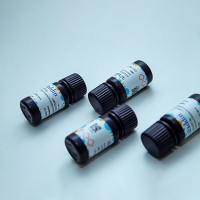High-Level Baculoviral Expression of Hormone-Sensitive Lipase
互联网
2711
The limited availability of purified hormone-sensitive lipase (HSL) has been one of the major obstacles in working with this enzyme. The low tissue abundance (approx 1 �g HSL/g adipose tissue) and the labile and hydrophobic character of HSL, are the major difficulties encountered in its purification ( 1 , 2 ). The cDNA cloning of HSL from several species ( 3 – 5 ) opened up the possibilities of establishing expression systems for HSL, to express and purify large amounts of recombinant enzyme. Initial attempts in our laboratory to express HSL, and fragments thereof, in Escherichia coli were unsuccessful, as HSL was found in inclusion bodies and attempts to renature the enzyme failed. Instead, we turned to the eukaryotic expression system based on baculovirus and insect cells, which proved to be a very suitable system for large-scale expression of HSL ( 6 ). In this system, approximately 40 mg HSL is produced per liter of suspension culture, with virtually no loss in the specific activity of the enzyme compared to the native HSL present in adipose tissue homogenates (Fig. 1 ). In fact, the enzyme purified to homogeneity from the baculovirus expression system has been shown to have properties indistinguishable from those of HSL purified from adipose tissue ( 6 ).
Fig. 1. Western blot analysis of recombinant rat HSL. Material corresponding to 1 mU of HSL activity from the different purification steps and 1 mU of HSL activity from a 110,000 g infranatant from rat adipose tissue ( 1 ) were subjected to Western blot analysis using a polyclonal rabbit antibody directed against rat adipose tissue HSL. The 84-kDa band corresponding to HSL is indicated. The intensity of the bands is similar in all lanes, indicating a similar specific activity for rat adipose tissue HSL and recombinant rat HSL.






